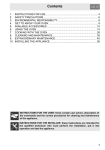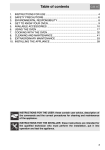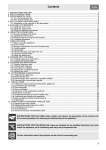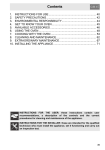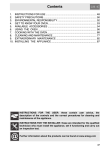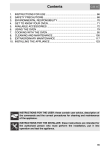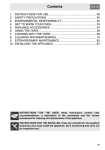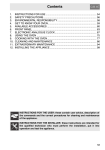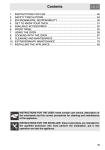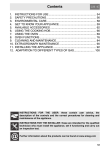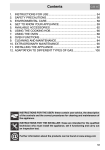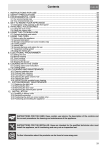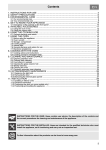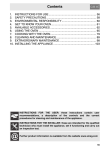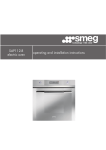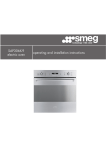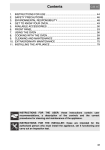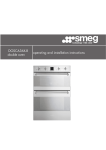Download 477 5213 SC805AO-8.book(03 477 5213 GB.fm)
Transcript
Contents 1. 2. 3. 4. 5. 6. 7. 8. 9. 10. INSTRUCTIONS FOR USE ......................................................................... 54 SAFETY PRECAUTIONS ............................................................................ 56 ENVIRONMENTAL RESPONSIBILITY ........................................................ 58 GET TO KNOW YOUR OVEN...................................................................... 59 AVAILABLE ACCESSORIES ....................................................................... 60 USING THE OVEN ...................................................................................... 66 COOKING WITH THE OVEN....................................................................... 74 CLEANING AND MAINTENANCE ............................................................... 82 EXTRAORDINARY MAINTENANCE ........................................................... 95 INSTALLING THE APPLIANCE ................................................................... 99 INSTRUCTIONS FOR THE USER: these instructions contain user recommendations, a description of the controls and the correct procedures for cleaning and maintenance of the appliance. INSTRUCTIONS FOR THE INSTALLER: these are intended for the qualified technician who must install the appliance, set it functioning and carry out an inspection test. @ Further information about the products can be found at www.smeg.com 53 General instructions 1. INSTRUCTIONS FOR USE THIS MANUAL IS AN INTEGRAL PART OF THE APPLIANCE. IT MUST BE KEPT IN ITS ENTIRETY AND IN AN ACCESSIBLE PLACE FOR THE WHOLE WORKING LIFE OF THE APPLIANCE. CAREFUL READING OF THIS MANUAL AND ALL THE INSTRUCTIONS THEREIN BEFORE USING THE APPLIANCE IS ESSENTIAL. INSTALLATION MUST BE CARRIED OUT BY COMPETENT PERSONS IN ACCORDANCE WITH THE REGULATIONS IN FORCE. THIS APPLIANCE IS INTENDED FOR HOUSEHOLD USE AND COMPLIES WITH THE EEC DIRECTIVES CURRENTLY IN FORCE. THE APPLIANCE HAS BEEN BUILT TO CARRY OUT THE FOLLOWING FUNCTIONS: COOKING FOOD; ALL OTHER USES ARE CONSIDERED UNSUITABLE. THE MANUFACTURER CANNOT BE HELD LIABLE FOR USE OTHER THAN AS INDICATED. IF THE APPLIANCE IS INSTALLED ON BOATS OR IN CARAVANS, DO NOT USE IT AS A ROOM HEATER. DO NOT USE THIS APPLIANCE FOR HEATING ROOMS. THIS APPLIANCE IS MARKED ACCORDING TO EUROPEAN DIRECTIVE 2002/96/EC ON WASTE ELECTRICAL AND ELECTRONIC EQUIPMENT (WEEE). THIS DIRECTIVE DEFINES THE STANDARDS FOR THE COLLECTION AND RECYCLING OF WASTE ELECTRICAL AND ELECTRONIC EQUIPMENT APPLICABLE THROUGHOUT THE EUROPEAN UNION. NEVER OBSTRUCT THE OPENINGS AND SLITS PROVIDED FOR VENTILATION AND HEAT DISPERSAL. DO NOT REST ANY WEIGHT OR SIT ON THE OPEN DOOR OF THE APPLIANCE. THE IDENTIFICATION PLATE WITH THE TECHNICAL DATA, SERIAL NUMBER AND BRAND NAME HAS BEEN VISIBLY AFFIXED TO THE APPLIANCE. DO NOT REMOVE THIS PLATE FOR ANY REASON. BEFORE THE APPLIANCE IS PUT INTO OPERATION, ALL THE PROTECTIVE FILMS APPLIED INSIDE OR OUTSIDE MUST BE REMOVED. TAKE CARE THAT NO OBJECTS ARE STUCK IN THE DOOR OF THE OVEN. THE APPLIANCE BECOMES VERY HOT INSIDE DURING USE. SUITABLE HEATPROOF GLOVES SHOULD BE WORN FOR ALL OPERATIONS. 54 General instructions DO NOT USE STEEL SPONGES AND SHARP SCRAPERS AS THEY WILL DAMAGE THE SURFACE. USE NORMAL NON-ABRASIVE PRODUCTS, INCLUDING WOODEN OR PLASTIC UTENSILS IF NECESSARY. RINSE THOROUGHLY AND DRY USING A SOFT CLOTH OR A MICROFIBRE CLOTH. DO NOT ALLOW RESIDUES OF SUGARY FOODS (SUCH AS JAM) TO SET INSIDE THE OVEN. IF THEY ARE ALLOWED TO SET FOR TOO LONG, THEY COULD RUIN THE ENAMEL COVERING THE INSIDE OF THE OVEN. DO NOT USE PLASTIC KITCHENWARE OR CONTAINERS. THE HIGH TEMPERATURES INSIDE THE OVEN COULD MELT THE PLASTIC, DAMAGING THE APPLIANCE. DO NOT USE SEALED TINS OR CONTAINERS IN THE APPLIANCE. OVERPRESSURE MAY OCCUR INSIDE THE CONTAINERS DURING COOKING, CREATING A DANGER OF EXPLOSION. DO NOT LEAVE THE APPLIANCE UNATTENDED DURING COOKING PROCESSES WHERE FATS OR OILS COULD BE RELEASED. FATS AND OILS MAY CATCH FIRE. DO NOT COVER THE BOTTOM OF THE OVEN WITH ALUMINIUM OR TINFOIL SHEETS DURING COOKING AND DO NOT PLACE PANS OR TRAYS ON IT TO AVOID DAMAGE TO THE ENAMELLED SURFACE. IF THE SURFACES ARE STILL VERY HOT DURING COOKING, DO NOT POUR WATER DIRECTLY ONTO THE TRAYS. THE STEAM COULD CAUSE SEVERE BURNS AND DAMAGE TO ENAMELLED SURFACES. ALL COOKING OPERATIONS MUST TAKE PLACE WITH THE DOOR CLOSED. 55 General instructions 2. SAFETY PRECAUTIONS REFER TO THE INSTALLATION INSTRUCTIONS FOR THE SAFETY REGULATIONS FOR ELECTRIC OR GAS APPLIANCES AND VENTILATION FUNCTIONS. IN YOUR INTERESTS AND FOR YOUR SAFETY THE LAW REQUIRES THAT THE INSTALLATION AND SERVICING OF ALL ELECTRICAL APPLIANCES IS CARRIED OUT BY QUALIFIED PERSONNEL IN ACCORDANCE WITH THE REGULATIONS IN FORCE. OUR APPROVED INSTALLERS GUARANTEE A SATISFACTORY JOB. GAS OR ELECTRICAL APPLIANCES MUST ALWAYS BE DISCONNECTED BY SUITABLY SKILLED PEOPLE. BEFORE CONNECTING THE APPLIANCE TO THE POWER GRID, CHECK THE DATA ON THE PLATE AGAINST THE DATA FOR THE GRID ITSELF. BEFORE CARRYING OUT INSTALLATION/MAINTENANCE WORK, MAKE SURE THAT THE APPLIANCE IS NOT CONNECTED TO THE POWER GRID. THE PLUG TO BE CONNECTED TO THE POWER SUPPLY CABLE AND ITS SOCKET MUST BE OF THE SAME TYPE AND CONFORM TO THE REGULATIONS IN FORCE. THE SOCKET MUST BE ACCESSIBLE AFTER THE APPLIANCE HAS BEEN BUILT IN. NEVER DISCONNECT THE PLUG BY PULLING ON THE CABLE. IF THE POWER SUPPLY CABLE IS DAMAGED, CONTACT THE TECHNICAL SUPPORT SERVICE IMMEDIATELY AND THEY WILL REPLACE IT. IT IS OBLIGATORY FOR ALL ELECTRICAL EQUIPMENT TO BE EARTHED ACCORDING TO THE METHODS LAID DOWN BY SAFETY REGULATIONS. IMMEDIATELY AFTER INSTALLATION, CARRY OUT A BRIEF INSPECTION TEST, FOLLOWING THE INSTRUCTIONS BELOW. SHOULD THE APPLIANCE NOT FUNCTION, DISCONNECT IT FROM THE ELECTRICITY SUPPLY AND CALL THE NEAREST TECHNICAL SUPPORT CENTRE. NEVER ATTEMPT TO REPAIR THE APPLIANCE. NEVER PUT INFLAMMABLE OBJECTS IN THE OVEN: IF IT IS SWITCHED ON BY ACCIDENT, IT MAY CAUSE A FIRE. DURING USE THE APPLIANCE BECOMES VERY HOT. TAKE CARE NOT TO TOUCH THE HEATING ELEMENTS INSIDE THE OVEN. THIS APPLIANCE MAY NOT BE USED BY PEOPLE (INCLUDING CHILDREN) OF REDUCED PHYSICAL AND MENTAL CAPACITY, OR LACKING IN EXPERIENCE IN THE USE OF ELECTRICAL APPLIANCES, UNLESS THEY ARE SUPERVISED OR INSTRUCTED BY ADULTS RESPONSIBLE FOR THEIR SAFETY. 56 General instructions DO NOT LET CHILDREN GO NEAR THE APPLIANCE WHEN IT IS IN OPERATION OR PLAY WITH IT AT ANY TIME. DO NOT INSERT POINTED METAL OBJECTS (CUTLERY OR UTENSILS) INTO THE SLITS IN THE APPLIANCE. DO NOT USE STEAM JETS FOR CLEANING THE APPLIANCE. THE STEAM COULD REACH THE ELECTRONICS, DAMAGING THEM AND CAUSING SHORT-CIRCUITS. DO NOT MODIFY THIS APPLIANCE. DO NOT SPRAY ANY SPRAY PRODUCTS NEAR THE ELECTRICAL APPLIANCE WHILE IT IS IN OPERATION. DO NOT USE SPRAY PRODUCTS WHILE THE PRODUCT IS STILL HOT. The manufacturer cannot be held liable for damage to persons or things caused by failure to observe the above instructions, by interference with any part of the appliance or by the use of non-original spare parts. 57 Instructions for disposal 3. ENVIRONMENTAL RESPONSIBILITY 3.1 Our environmental responsibility Pursuant to Directives 2002/95/EC, 2002/96/EC and 2003/108/EC relating to the reduction of the use of hazardous substances in electrical and electronic appliances, as well as to the disposal of refuse, the crossed out bin symbol on the appliance indicates that at the end of the useful life of the product, it must be collected separately from other refuse. Therefore, the user must consign the product that has reached the end of its working life to the appropriate selective collection centres for electrical and electronic refuse, or deliver it back to the retailer when purchasing an equivalent product, on a one for one basis. Adequate differentiated collection for the subsequent forwarding of the decommissioned product to recycling, processing and ecologically compatible disposal contributes to avoiding possible negative effects on the environment and on health, and promotes recycling of the appliance's constituent materials. Illicit disposal of the product by the user will lead to the application of administrative sanctions. The product does not contain substances in quantities sufficient to be considered hazardous to health and the environment, in accordance with current European directives. 3.2 Your environmental responsibility Our product's packing is made of non-polluting materials, therefore compatible with the environment and recyclable. Please help by disposing of the packaging correctly. You can obtain the addresses of collection, recycling and disposal centres from your retailer or from the competent local organisations. Do not discard the packaging or any part of it, or leave it unattended. It can constitute a suffocation hazard for children, especially the plastic bags. Your old appliance also needs to be disposed of correctly. Important: hand over your appliance to the local agency authorised for the collection of electrical appliances no longer in use. Correct disposal enables intelligent recovery of valuable materials. Before disposing of your appliance it is important to remove doors and leave shelves in the same position as for use, to ensure that children cannot accidentally become trapped inside during play. It is also necessary to cut the connecting cable to the power supply network, removing it along with the plug. 58 Instructions for the user 4. GET TO KNOW YOUR OVEN Control panel Upper guard Oven light Rack and tray support runners (on some models only) Rack and tray support frames (on some models only) Self-cleaning panels Multifunction Model Oven fan Insert for the rotisserie rod (on some models only) Pyrolytic Model 59 Instructions for the user 5. AVAILABLE ACCESSORIES NOTE: Some models accessories. are Rack: for holding cooking containers. Tray rack: to be placed over the top of the oven tray; for cooking foods which may drip. Oven tray: for collecting fat from foods placed on the rack above. Deep oven tray: for baking cakes, pizza and oven desserts. Pizza plate: specially designed for cooking pizza and similar dishes. Pizza spatula: for easy placement of the pizza on the pizza plate. 60 not provided with all Instructions for the user Pizza plate cover: for covering the pizza plate when it is not in use. Rotisserie frame: supports the rotisserie rod. Rotisserie rod: for cooking chicken and all foods which require uniform cooking over their entire surface. • Accessories available on request: Original supplied and optional accessories may be ordered from any Authorised Support Centre. • Use original SMEG accessories only. 61 Instructions for the user 5.1 Using the rack or tray The racks and trays are equipped with a mechanical safety lock which prevents them from being taken out accidentally. To insert the rack or tray correctly, check that the lock is facing downwards (as shown in the figure). To remove the rack or tray, lift the front slightly. The mechanical lock (or the skirt where present) must always face the back of the oven. Ovens with frames Ovens with runners Insert racks and trays fully into the oven until they come to a stop. In models with runners, clean the trays before using them for the first time. Cleaning will remove any manufacturing residues, which may otherwise scratch the sides of the oven cavity when trays are being inserted. 5.2 Using the support rack The support rack is inserted into the tray (as shown in the figure). Using this, foods can be cooked and the fat can be collected separately from the food which is being cooked. 62 Instructions for the user 5.3 Using the rotisserie rod (on some models only) When cooking with the rotisserie, position the frame on the third runner (see 6.2.1 Oven runners). Once the frame is inserted, the shaped part must sit facing outwards (as shown in the figure). Then prepare the rotisserie rod with the food, using the clip forks provided. So that you can handle the rod with the food on it readily, screw on the handle provided. Having prepared the rotisserie rod with the food, position it on the guide frame as shown in the figure. Insert the rod into the hole (detail B) so that it connects with the rotisserie motor. Make sure that the pin is placed correctly on the guide frame (detail A). Ovens with runners Ovens with runners 63 Instructions for the user 5.4 Using the pizza plate (on some models only) With the oven cold, remove the circular cover from the bottom (as shown in the figure) and insert the pizza plate. Make sure that the plate is inserted correctly in the recess provided. For cooking use the special pizza function Ovens with frames . Ovens with runners Do not use the pizza plate other than as described, for example do not use it on gas or glass ceramic hobs or in ovens which are not designed for this purpose. If you wish to add oil to your pizza, it is best to add it after removing it from the oven since oil stains on the pizza plate are unsightly and may reduce its efficiency. In models where it is provided, if the pizza plate is not in use, cover the bottom of the oven with the cover provided. 64 Instructions for the user 5.5 Using the pizza spatula (on some models only) Always grip the pizza spatula on the wooden handle to put food in and take it out of the oven. You are advised to dust the steel surface lightly with flour to make it easier to slide fresh products on and off, as they could stick to the steel due to their moisture content. Ovens with frames Ovens with runners 65 Instructions for the user 6. USING THE OVEN 6.1 Before using the appliance • Remove any labels (apart from the technical data plate) from trays, dripping pans and the cooking compartment. • Remove any protective film from the outside or inside of the appliance, including from accessories such as trays, dripping pans, the pizza plate or the base cover. • Before using the appliance for the first time, remove all accessories from the oven compartment and wash them as indicated in “8. CLEANING AND MAINTENANCE”. Heat the empty appliance to the maximum temperature in order to remove any manufacturing residues which could affect the food with unpleasant odours. 6.2 General Description 6.2.1 Oven runners The oven features 4 runners for positioning trays and racks at different heights. The insertion heights are indicated from the bottom upwards (see figure). Ovens with frames 66 Ovens with runners Instructions for the user 6.2.2 Cooling system The appliance is equipped with a cooling system which comes into operation as soon as a cooking function starts. The fan causes a steady outflow of air from above the door which may continue for a brief period of time even after the oven has been turned off. 6.2.3 Oven inside lights The oven lights come on when the door is opened (only on some models) or any function or recipe is selected, except for , and (where present). 67 Instructions for the user 6.3 Warnings and general advice for usage All cooking operations must be carried out with the door closed. Only in multifunction models: when using the fan-assisted grill for longer than 20 minutes, never set the temperature above 200°C. During cooking, do not cover the bottom of the oven with aluminium or tin foil and do not place pans or oven trays on it as this may damage the enamel coating. If you wish to use greaseproof paper, place it so that it will not interfere with the hot air circulation inside the oven. For the best cooking results, we recommend placing cookware in the centre of the rack. To prevent any steam in the oven from causing problems, open the door in two stages: half open (5 cm approx.) for 4-5 seconds and then fully open. If you need to access the food, always leave the door open for as short a time as possible to prevent the temperature in the oven from falling and ruining the food. To prevent excessive amounts of condensation from forming on the internal glass, hot food should not be left inside the oven for too long after cooking. 68 Instructions for the user 6.4 Description of the controls on the front panel All the appliance's control and monitoring devices are located together on the front panel. OVEN THERMOSTAT KNOB This knob can be used to select the cooking temperature. Turn the knob clockwise to the desired value, between 50°C and 250°C. 69 Instructions for the user THERMOSTAT LIGHT (on some models only) When this is flashing, it indicates that the oven is heating up to the temperature set using the thermostat knob. Once the oven has reached the selected temperature: Multifunction models: When the light flashes regularly, it means that the temperature inside the oven is kept steady on the set level. Pyrolytic models: the light stops flashing and remains steady until the oven switches off. Moreover, the light switches on when the automatic cleaning cycle (pyrolysis) starts and remains lit until the cycle is complete. PROGRAMMING CLOCK Multifunction Model Pyrolytic Model The programming clock can be used to display the current time or to set a timer (only on multifunction models) or cooking programme (only for pyrolytic models). DOOR LOCK (on some models only) In pyrolytic models, this light only comes on when the automatic cleaning cycle is activated. 70 Instructions for the user FUNCTION KNOB Turn the knob clockwise or anti-clockwise to select a function (some functions are not present on all models) from the following options: (See 7. COOKING WITH THE OVEN). 71 Instructions for the user 6.5 Programming clock on multifunction models A Manual pointer or timed cooking B Hour - minute pointers C Adjustment knob The programmer enables manual cooking or the timer to be selected, or the cooking time to be set. Select the desired function and cooking temperature before setting the cooking time. 6.5.1 Setting the time To set the correct time, pull out and rotate the knob C clockwise. 6.5.2 Manual cooking To use the oven with manual cooking, turn knob C clockwise until the A pointer is aligned with the symbol . 6.5.3 Timed cooking To set the cooking time, turn knob C clockwise until the A pointer is aligned with the required time (maximum 180 minutes). 6.5.4 End of cooking The oven will switch off automatically and simultaneously a buzzer will start to sound. 6.5.5 Stopping the buzzer To switch off the buzzer, turn knob C clockwise until the A pointer is aligned with the symbol 72 . Instructions for the user 6.6 Programming clock on pyrolitic models A Manual pointer or timed cooking B Hour - minute pointers C Adjustment knob D Cooking starting hand The programmer enables manual cooking or the timer to be selected, or the cooking time to be set. Select the desired function and cooking temperature before setting the cooking time. 6.6.1 Setting the time To set the correct time, pull out and rotate the knob C clockwise. 6.6.2 Timed cooking This function only switches the oven off automatically at the end of the cooking time. Turn knob C clockwise to set the cooking time in window A. 6.6.3 Programmed cooking This setting switches the oven on and off in fully automatic mode. Turn knob C clockwise until the symbol appears in window A. Pull out and rotate knob C clockwise until the pointer D is aligned with the desired cooking start time. Turn knob C clockwise to set the cooking time in window A. 6.6.4 End of cooking At the end of the cooking time the oven will switch off automatically and simultaneously a buzzer will start to sound intermittently. 6.6.5 Stopping the buzzer The buzzer can be switched off manually by turning knob A clockwise until the symbol appears in window B. In order to use the oven manually, turn knob C clockwise at the end of a programming procedure until the symbol appears in window A. 73 Instructions for the user 7. COOKING WITH THE OVEN ECO: Using the grill and the lower heating element in combination is particularly suitable for cooking on a single runner only, as it provides low energy consumption. STATIC: As the heat comes from above and below at the same time, this system is particularly suitable for certain types of food. Traditional cooking, also known as static or thermal radiation cooking, is suitable for cooking just one dish at a time. Perfect for all types of roasts, bread and cakes and in any case particularly suitable for fatty meats such as goose and duck. GRILL: The heat coming from the grill element gives perfect grilling results, especially for thin and medium thickness meat and, in combination with the rotisserie (when present), it allows the food to be browned evenly at the end of cooking. Perfect for sausages, ribs and bacon. This function enables large quantities of food, particularly meat, to be grilled evenly. (3rd or 4th runner). ROTISSERIE GRILL: The rotisserie functions in combination with the grill element allowing to perfectly brown food. BOTTOM: The heat coming solely from the bottom makes it possible to complete the cooking of foods that require a greater basic temperature, without affecting their browning. Perfect for cakes, pies, tarts and pizzas. FAN-ASSISTED STATIC: The operation of the fan, combined with traditional cooking, ensures uniform cooking even with complex recipes. Perfect for biscuits and cakes, even when simultaneously cooked on several levels. (For multiple-level cooking, you are advised to use the 1st and 3rd runners.) 74 Instructions for the user FAN-ASSISTED GRILL: The air produced by the fan softens the strong heatwave generated by the grill, giving perfect grilling results even with very thick foods. Perfect for large cuts of meat (e.g. shin of pork). We recommend using the 3rd runner. CIRCULAR: The combination of the fan and the circular element (incorporated in the rear of the oven) enables different foods to be cooked on several levels, as long as they need the same temperature and cooking time. Hot air circulation ensures instant and uniform distribution of heat. It will be possible, for instance, to cook fish, vegetables and biscuits simultaneously (on different levels) without mixing smells and flavours. (For multiple-level cooking, you are advised to use the 1st and 3rd runners.) TURBO: The combination of fan-assisted cooking and traditional cooking enables different foods to be cooked on several levels extremely quickly and efficiently, without any transfer of smells and flavours. Perfect for large volumes that call for intense cooking. (For multiple-level cooking, you are advised to use the 1st and 3rd runners.) DEFROSTING: The movement of air caused by the fan makes food defrost faster. The air circulating inside the oven is at room temperature. PIZZA: The operation of the fan, combined with the grill and the lower heating element, ensures uniform cooking even with complex recipes. Perfect not just for pizzas, but also for biscuits and cakes. 75 Instructions for the user 7.1 Cooking advice and instructions 7.1.1 General advice We recommend preheating the oven before putting the food in. For cooking on several levels, we recommend using a fan-assisted function ( , , ) to achieve uniform cooking at all heights. In general, it is not possible to shorten the cooking times by increasing the temperature (the food could be well-cooked on the outside and undercooked on the inside). While cooking desserts or vegetables, excessive condensation may form on the glass. In order to avoid this, open the door very carefully a couple of times while cooking. 7.1.2 Advice for cooking meat Cooking times, especially for meat, vary according to the thickness and quality of the food and to consumer taste. We recommend using a meat thermometer for meat when roasting it. Alternatively, simply press on the roast with a spoon: if it is hard, it is ready; if not, it needs another few minutes cooking. 7.1.3 Advice for cooking desserts and biscuits Use dark metal moulds for desserts: they help to absorb the heat better. The temperature and the cooking duration depend on the quality and consistency of the dough. Check whether the dessert is cooked right through: at the end of the cooking time, put a toothpick into the highest point of the dessert. If the dough does not stick to the toothpick, the dessert is cooked. If the dessert collapses when it comes out of the oven, on the next occasion reduce the set temperature by about 10?, selecting a longer cooking time if necessary. 76 Instructions for the user 7.1.4 Advice for defrosting and proving We recommend positioning frozen foods in a lidless container on the first runner of the oven. The food must be defrosted without its wrapping. Lay out the foodstuffs to be defrosted evenly, not overlapping. When defrosting meat, we recommend using a rack positioned on the second runner with the food on it and a tray positioned on the first runner. In this way, the liquid from the defrosting food drains away from the food. The most delicate parts can be covered with aluminium foil. For successful proving, a container of water should be placed in the bottom of the oven. 7.1.5 Advice for cooking with the Grill and the Fan-assisted grill Using the Grill function , meat can be grilled even when it is put into the oven cold; preheating is recommended if you wish to change the effect of the cooking. With the Fan-assisted grill function , however, we recommend that you preheat the oven before grilling. We recommend placing the food at the centre of the rack. 7.2 To save energy To save energy during use of the appliance, the following instructions may be followed: • Stop cooking a few minutes before the time normally used. Cooking will continue for the remaining minutes with the heat which has accumulated inside the oven. • Reduce any opening of the door to a minimum to avoid heat dispersal. • Use the ECO function (if fitted) for cooking on a single runner. • Keep the inside of the appliance clean at all times. 77 Instructions for the user 7.3 Cooking process information table TYPES OF FOOD WEIGHT FUNCTION FIRST COURSES LASAGNE 3 kg Static OVEN-BAKED PASTA Static MEAT ROAST VEAL 1 kg Fan-assisted static LOIN OF PORK 1 kg Fan-assisted static SHOULDER OF PORK 1 kg ROAST RABBIT 1 kg Circular TURKEY BREAST 1 kg Fan-assisted static ROAST NECK OF PORK 1 kg Turbo ROAST CHICKEN 1 kg Turbo - Turbo / Circular GRILLED MEATS PORK CHOPS Fan-assisted grill FILLET OF PORK Grill FILLET OF BEEF Grill LIVER Fan-assisted grill SAUSAGES Fan-assisted grill MEAT BALLS Grill ROTISSERIE MEATS CHICKEN Rotisserie grill FISH SALMON TROUT 78 0.7 kg Fan-assisted static Instructions for the user RUNNER POSITION FROM BOTTOM TEMPERATURE °C TIME IN MINUTES 1 or 2 220 - 230 40 - 50 1 or 2 220 - 230 40 2 180 - 190 70 - 80 2 180 - 190 70 - 80 2 180 - 190 90 - 100 2 180 - 190 70 - 80 2 180 - 190 110 - 120 2 180 - 190 110 - 120 2 190 - 200 60 - 70 1ST SURFACE 2ND SURFACE 4 250 - 280 7-9 5-7 3 250 - 280 9 - 11 5-9 3 250 - 280 9 - 11 9 - 11 4 250 - 280 2-3 2-3 3 250 - 280 7-9 5-6 3 250 - 280 7-9 5-6 On a rotisserie rod 250 - 280 60 - 70 2 160 - 170 35 - 40 79 Instructions for the user TYPES OF FOOD WEIGHT FUNCTION PIZZA Fan-assisted static PIZZA (on pizza plate) Pizza BREAD Circular FOCACCIA - Turbo / Circular DESSERTS DOUGHNUT Fan-assisted static FRUIT TART Fan-assisted static FRUIT TART Static SHORT PASTRY Circular JAM TARTS - Turbo / Circular PARADISE CAKE Fan-assisted static PARADISE CAKE Static ECLAIR - LIGHT SPONGE CAKE RICE PUDDING Turbo / Circular Circular - Turbo / Circular RICE PUDDING Static CROISSANTS Circular APPLE PIE Static CROISSANTS (on multiple runners) SHORT PASTRY BISCUITS (on multiple runners) The times indicated in the following tables do not include the preheating times and are provided as a guide only. 80 Instructions for the user RUNNER POSITION FROM BOTTOM TEMPERATURE °C TIME IN MINUTES 1 280 8 pizza plate 280 4 2 190 - 200 30 -35 2 180 - 190 15 -20 2 160 - 170 50 - 55 2 160 - 170 30 - 35 2 170 35 - 40 2 160 - 170 20 - 25 2 170 20 - 25 2 160 - 170 50 - 60 2 170 50 - 60 2 150 - 160 40 - 50 2 150 - 160 45 - 50 2 160 40 - 50 2 170 50 - 60 2 160 25 - 30 3 180 60 1 and 3 160 - 170 16 - 20 1 and 3 160 - 170 16 - 20 For cooking on multiple runners, we recommend that you use functions , and only, and the 1st and 3rd runners. 81 Instructions for the user 8. CLEANING AND MAINTENANCE NEVER USE A JET OF STEAM FOR CLEANING THE APPLIANCE. We recommend the use of cleaning products distributed by the manufacturer. Do not use cleaning products containing chlorine, ammonia or bleach on steel parts or parts with metallic finishes on the surface (e.g. anodizing, nickel- or chromium-plating). 8.1 Cleaning stainless steel To keep stainless steel in good condition it should be cleaned regularly after use. Let it cool first. 8.2 Ordinary daily cleaning To clean and preserve the stainless steel surfaces, always use only specific products that do not contain abrasives or chlorine-based acids. How to use: pour the product onto a damp cloth and wipe the surface, rinse thoroughly and dry with a soft cloth or a microfibre cloth. 8.3 Food stains or residues Do not use steel sponges or sharp scrapers as they will damage the surface. Use normal non-abrasive products and a wooden or plastic tool if necessary. Rinse thoroughly and dry with a soft cloth or a microfibre cloth. Do not allow residues of sugary foods (such as jam) to set inside the oven. If left to set for too long, they might damage the enamel lining of the oven. 8.4 Cleaning the door glazing The glass in the door should always be kept thoroughly clean. Use absorbent kitchen roll; remove stubborn dirt with a damp sponge and an ordinary detergent. Do not use abrasive or corrosive cleaners for cleaning the door glazing (e.g. powder products, stain removers and metal scouring pads). Do not use rough or abrasive materials or sharp metal scrapers to clean the oven's glass doors since they may scratch the surface. 82 Instructions for the user 8.5 Cleaning the inside of the oven For the best oven upkeep, clean it regularly after having allowed it to cool. • Take out all removable parts. • Clean the oven racks with hot water and non-abrasive detergent. Rinse and dry. • For easier cleaning, the door can be removed (see “9.2 Removing the door”). The oven should be operated at the maximum temperature for about 15-20 minutes after the use of specific products, to burn off the residues left inside the oven. 83 Instructions for the user On pizza models only, to clean the bottom of the oven, the following operations have to be carried out first: Remove the cover then the base on which it is resting. The base must be lifted a few millimetres, then pulled outwards. Ovens with frames Ovens with runners Lift up the edge of the lower heating element a few centimetres and clean the bottom. Put the pizza plate support back in place, pushing it in until it hits the back of the oven, and push it down so that the heating element plate is embedded into the base itself. Ovens with frames Ovens with runners When the operation is complete, damp parts should be dried thoroughly. 84 Instructions for the user 8.5.1 Removing guide frames and self-cleaning panels Removing the guide frames and selfcleaning panels makes it easier to clean the side parts, and it also needs to be done whenever the assisted cleaning cycle is used (only available on some models). • To remove the guide frames, pull the frame towards the inside of the oven to unhook it from its housing A, then slide it out of the seats at the back B. • When cleaning is complete, repeat the above procedures to put the guide frames back in. 85 Instructions for the user 8.6 Cleaning self-cleaning panels (catalysis cycle) If the self-cleaning panels are dirty, primarily with small amounts of grease, a heating cycle can be executed to regenerate them. Clean the base and the roof liner first with a microfibre cloth soaked in water and neutral washing up liquid, then rinse thoroughly. Set a regeneration cycle by selecting a fan function at the maximum temperature for one hour. (see “6.4 Description of the controls on the front panel”). If the panels are particularly dirty, after the regeneration cycle, remove them and wash them with neutral washing up liquid. Then rinse and dry them. Put the panels back in the oven and set a fan function at a temperature of 180°C for o


















































